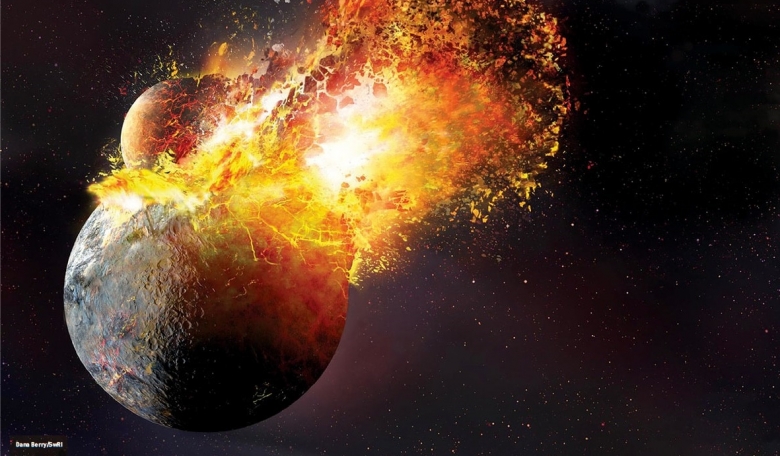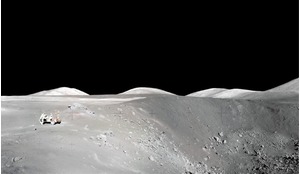The Apollo exploration era produced an enormous amount of scientific information about our nearest celestial neighbour, the Moon, and a significant understanding of its importance. Within the past 10 years another revolution in lunar science, focusing on the north and south poles of the Moon, has suggested the presence of volatiles, including water. NASA’s Chief Scientist James Green and Deputy Chief Scientist David Draper discuss the mechanisms behind this and what it means for the Artemis lunar programme.
The Moon plays a number of critical roles in keeping the Earth ‘uncommonly habitable’ as it generates tides, stabilises the planet’s spin axis and slows its rotation rate, all of which we believe are important for the development of complex life.
From remote sensing data - which are in turn grounded in studies of Apollo-era lunar samples - it has been determined that the Moon holds a significant amount of frozen water (H2O) and hydroxyl (OH) in its permanently shadowed regions (PSRs), and as lunar scientists dig deeper to understand how it got there a whole new world of exciting results is emerging.
It now appears that, in the PSRs, we may be able to uncover trapped volatiles that can tell us about asteroid and comet composition, the early atmosphere of the Earth and whether the early Moon had an atmosphere. It is hard to imagine, but we now think we have found in the PSRs a time capsule of the history of the volatiles in our solar system. To understand how this occurred we have to start at the beginning.
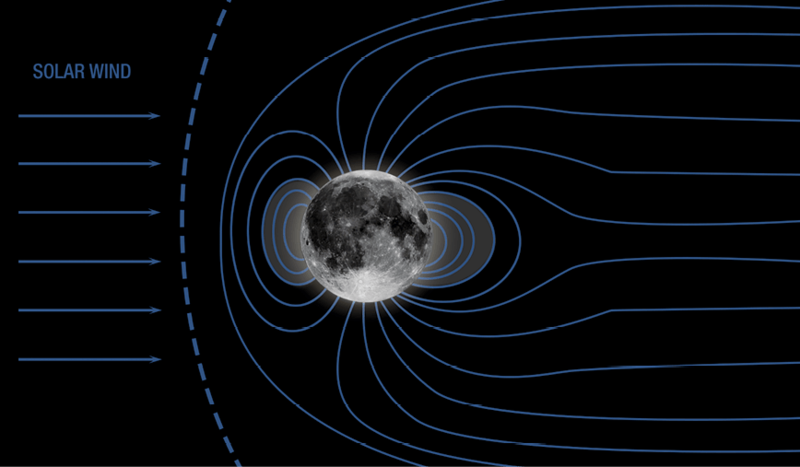 The lunar magnetosphere protecting its tenuous atmosphere from the solar wind and allowing Earth’s early atmosphere a pathway to be deposited onto the lunar surface in both the northern and southern polar caps.
The lunar magnetosphere protecting its tenuous atmosphere from the solar wind and allowing Earth’s early atmosphere a pathway to be deposited onto the lunar surface in both the northern and southern polar caps.
Back story
The collision caused both planets to temporarily splatter apart into globs of gas, magma, volatiles and other chemical elements before reforming into the bodies we know today as Earth and Moon
A little more than four and a half billion years ago an interstellar cloud began to collapse. The Sun was forming at the centre and accretion of dust was building the system’s early bodies, known as planetesimals, the remnants of which are the asteroids and comets found in our solar system today. The later accretion of planetesimals is what forms the much larger differentiated protoplanets.
The differentiation process - the internal rearrangement of a body producing the heavier material at the centre and progressively lighter materials out towards the surface - starts at about 400 or 500 km in diameter. Terrestrial planets are quickly created from the accretion of protoplanets creating an epoch of giant impacts, which may have blown away most of the crust of Mercury, or resulted in flipping the rotational axis of Venus, or created the lowlands of Mars in the northern hemisphere.
The leading theory for the origin of the Earth-Moon system is also one of a giant impact of protoplanets. When the proto-Earth was forming, the theory goes, it was hit by another emerging protoplanet named Theia, about the size that Mars is today. The collision caused both planets to temporarily splatter apart into globs of gas, magma, volatiles and other chemical elements before reforming into the bodies we know today as the Earth and Moon. The formation of the Moon occurred at a location about three Earth radii away from the Earth, which is incredibly close compared to the current situation. Over time, the Moon has moved away from the Earth because of tidal dissipation and today is at 60 Earth radii.
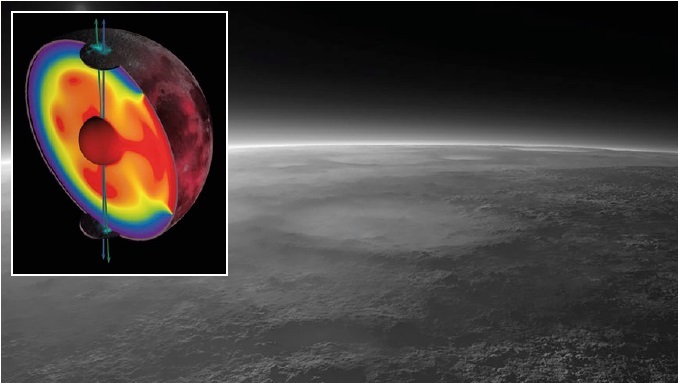 Large planetesimal impacts on the Moon result in magma filling the resulting craters in addition to generating a lunar atmosphere from the resulting outgassing. These volcanic rock regions are the dark-coloured maria that we see on the Moon today.
Large planetesimal impacts on the Moon result in magma filling the resulting craters in addition to generating a lunar atmosphere from the resulting outgassing. These volcanic rock regions are the dark-coloured maria that we see on the Moon today.
Sample analysis
More detailed analysis of the returned Apollo lunar samples using modern techniques has revealed that the early Moon had a substantial magnetic field
Recently, more detailed analysis of the returned Apollo lunar samples using modern techniques has revealed that the early Moon had a substantial magnetic field, a magnetosphere, that lasted for the first several hundred million years of its existence. This early era of the Moon’s magnetosphere has now been modelled and some surprising results have emerged.
Since the Moon was very close to the Earth during the time it had a magnetosphere, its proximity provided an opportunity for extensive magnetic coupling to occur between the Earth and the Moon. At locations where the magnetic field of the two bodies was antiparallel (parallel but in opposite directions), the fundamental process of reconnection provided a pathway for the early Earth’s evaporated atmosphere to travel along the magnetic field lines all the way to the Moon, where the volatiles could be stored in the lunar soil - protected against the ravages of the solar wind.
Observations of the nitrogen embedded in lunar soils, potentially of Earth origin, have been made for some time, but the mechanism of getting it there was not well established until the recent discovery and modelling of the early lunar magnetosphere. A recent re-analysis of the remotely sensed data from lunar polar regions showed widespread hematite (Fe2O3), which seemingly requires the delivery of oxygen from the Earth. Such a process can now also be explained by this newly understood magnetic pathway between the Earth and the Moon.
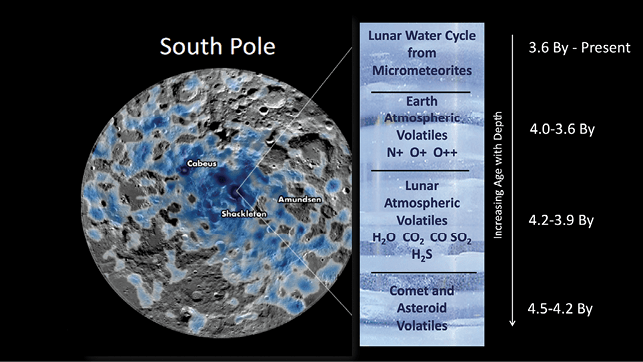 The topography of the lunar south pole with embedded water ice (blue shading). Many of these craters are completely shaded from the solar wind and solar electromagnetic radiation and are the coldest places in the solar system. Volatiles have been accumulating in these cold traps for billions of years.
The topography of the lunar south pole with embedded water ice (blue shading). Many of these craters are completely shaded from the solar wind and solar electromagnetic radiation and are the coldest places in the solar system. Volatiles have been accumulating in these cold traps for billions of years.
Another spectacular analysis that has recently emerged is centred around the bombardment of the Moon some 3.8-4.0 billion years ago, during a period we call the ‘late heavy bombardment’. It was during this time that large planetesimals were impacting the Moon and blowing away a significant portion of the lunar crust. Lava from the lower crust and upper mantle later oozed into these huge cratered regions, accompanied by the degassing of the molten rock, and formed a tenuous atmosphere of about 10 millibars pressure (about one percent of Earth’s).
The strength of the lunar magnetosphere appears to have been at its maximum around this time period and this magnetically-protected early lunar atmosphere would have played a key role in transporting any volatiles, from the Moon and from the Earth, across the lunar surface to be sequestered into the cold traps of permanently shadowed lunar polar regions.
Reconnection provided a pathway for the early Earth’s evaporated atmosphere to travel along the magnetic field lines all the way to the Moon
Further, according to the theory, about 3.2 billion years ago, the lunar magnetosphere faded rapidly. The Moon was nearly 30 Earth radii away and fully exposed to the ravages of the solar wind when its orbit placed it outside the Earth’s magnetosphere. The loss of the lunar magnetosphere doomed the lunar atmosphere, stripping it away and leaching out most of the trapped volatiles in the lunar soils over time.
Micrometeors also played their role in releasing trapped near-surface volatiles, and even today we observe bursts of ‘buried lunar water’ being emitted when the Moon passes through particulate debris from disintegrated comets and asteroids. Impacts from meteors of all sizes, even though they occur far less frequently today than in early solar system history, have continually pulverised the upper tens of metres of the lunar surface to form what is known as regolith, which consists of particles of pre-existing rocks ranging from less than one millionth of a metre to the size of a large house.
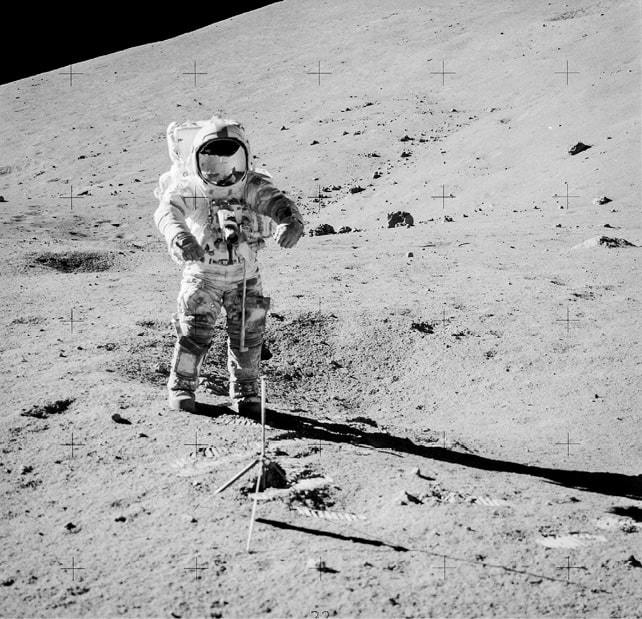 Apollo 17 astronaut Gene Cernan preparing to collect samples 73001 and 73002.
Apollo 17 astronaut Gene Cernan preparing to collect samples 73001 and 73002.
Artemis to the Moon
Orbiting instruments have determined that the permanently shadowed regions of the Moon are the coldest places ever measured in the solar system, but just how cold are the PSRs? They are colder than the cloud tops of the gas-giant planets, colder even than the mountains of nitrogen ice on Pluto. So, clearly, any icy volatile that falls into one of these cold traps stays cold! And because the traps are permanently shaded, they are, by definition, places where the Sun doesn’t shine… so the volatiles never warm up enough to escape.
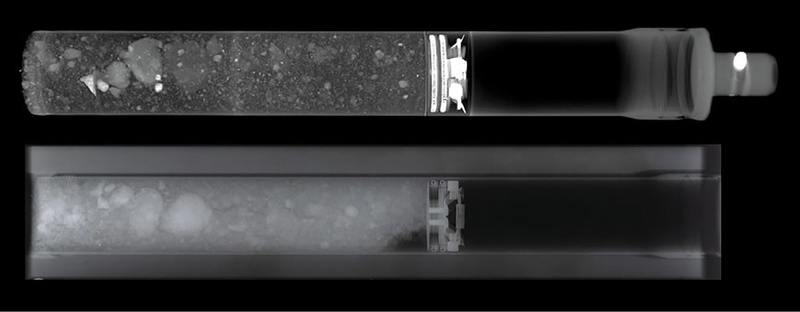 The bottom scan of lunar sample 73002 was taken using radiograph technology in 1974 by NASA. The X-Ray Computed Microtomography scan (top) above was taken in 2019 at the University of Texas at Austin. This is one example of the technological developments that are enabling a new generation to conduct new science on Apollo samples.
The bottom scan of lunar sample 73002 was taken using radiograph technology in 1974 by NASA. The X-Ray Computed Microtomography scan (top) above was taken in 2019 at the University of Texas at Austin. This is one example of the technological developments that are enabling a new generation to conduct new science on Apollo samples.
We don’t yet know whether the processes of regolith formation and evolution are exactly the same at the lunar poles as they are in the near-equatorial region of the lunar nearside, where all the Apollo missions (and the robotic Luna sample-return missions of the former Soviet Union) were sent. We do not yet have samples of this material, because we have not been there yet, but we expect regolith to be present within PSRs just as it is present at lower latitudes on the Moon. It would be great if all the layers of regolith in which volatiles are contained were sitting undisturbed, like a nice layer cake, with the oldest material on the bottom and the youngest on the top. But by its very nature, regolith formation stirs and churns the regolith like some great cosmic eggbeater, a process that scientists refer to as ‘regolith gardening’.
The good news, though, is that there may be sensitive ‘geochemical fingerprints’ in the volatiles that reveal some of their best-kept secrets. Some of these fingerprints may help us ‘see through’ the complicated physical processes of regolith formation and determine, for example, whether the isotopic composition of the elements making up the volatile materials is the same as on Earth.
The loss of the lunar magnetosphere doomed the lunar atmosphere, stripping it away and leaching out most of the trapped volatiles in the lunar soils over time
The even better news is that NASA’s Artemis programme to return humans to the Moon by 2024, and the robotic precursor missions that will precede it, will eventually return samples of these materials to Earth, where they can be studied in great detail in laboratories around the world. In ancient mythology, Artemis was the sister of Apollo, so Artemis is a very fitting title for the programme that will land the first woman and the next man on the lunar surface.
NASA’s Johnson Space Center in Houston, Texas, is home to the Astromaterials Acquisition and Curation Office, where the Apollo samples have been kept in absolutely pristine condition since their return from the Moon in the 1970s. The laboratories are today actively planning for the arrival of the precious lunar polar samples collected as part of the Artemis programme.
One of the robotic precursor missions that will prepare the way for the Artemis landings is the Volatiles Investigating Polar Exploration Rover, or VIPER, which is currently planned for a lunar arrival in 2023. Delivered by Astrobotic, a commercial space company based in Pittsburgh, Pennsylvania, VIPER will perform vital reconnaissance of a south polar area. It will locate volatile deposits and estimate their concentrations using on-board instruments and attempt to determine the physical state of preserved volatiles, as well as other potentially useful resources. This approach is a major departure from that during Apollo, because Artemis and its robotic precursor missions are part of NASA’s strategy of establishing a sustainable, long-term human presence on the Moon as opposed to the sortie-type Apollo missions. Another hallmark of Artemis that sets it apart from Apollo is the heavy involvement of the vibrant commercial and international space sectors instead of being a US government-only effort.
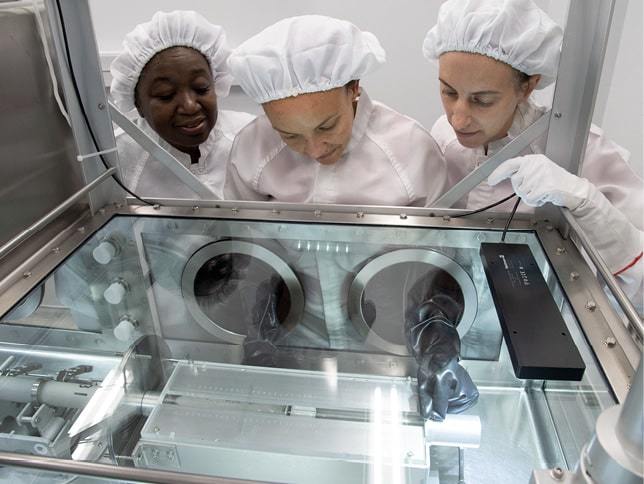 Apollo sample processors Andrea Mosie, Charis Krysher and Juliane Gross open lunar sample 73002 at NASA’s Johnson Space Center in Houston. Lunar rocks inside this tube had remained untouched since they were collected on the surface and brought to Earth by Apollo astronauts nearly 50 years ago.
Apollo sample processors Andrea Mosie, Charis Krysher and Juliane Gross open lunar sample 73002 at NASA’s Johnson Space Center in Houston. Lunar rocks inside this tube had remained untouched since they were collected on the surface and brought to Earth by Apollo astronauts nearly 50 years ago.
Why is it so important for human exploration to find these volatiles? The long-term presence of humans will require that we learn to ‘live off the land’ as much as possible. It is very expensive to launch mass from Earth so anything that is locally sourced is one less thing we need to bring with us. Water ice is among the most precious resources we could find, because not only is it life for human settlers, it can be used to make rocket fuel right on the Moon.
Regolith formation stirs and churns the regolith like some great cosmic eggbeater, a process that scientists refer to as ‘regolith gardening’
In addition, we are now coming to the realisation that there may also be a number of other important volatiles trapped in the PSRs. Extracting all these volatiles for use is a major game-changer for the human exploration of space, creating a jumping-off point to Mars and other destinations. VIPER and other precursor missions will set the stage for the eventual collection and retrieval of cores drilled from these volatile-bearing deposits, in similar fashion to the cores returned by several of the Apollo missions. Because of regolith gardening, these cores are unlikely to capture an obvious, perfect record of the ‘time stratigraphy’ of the materials, but they will reveal clues available in no other way about where these volatiles came from and how they were preserved.
NASA is already elevating its game on analysing lunar cores via the Apollo Next Generation Sample Analysis programme, in which a sealed core returned by the Apollo 17 astronauts - unopened in all the years since - is now under study at NASA Johnson. A team composed both of current and original-generation Apollo scientists (including Dr. Harrison H. ‘Jack’ Schmitt, Apollo 17 lunar module pilot and the only trained geologist to live and work on another world) is establishing exactly how best to work on the samples using the priceless experience gained in the almost fifty years since the last Apollo landing.
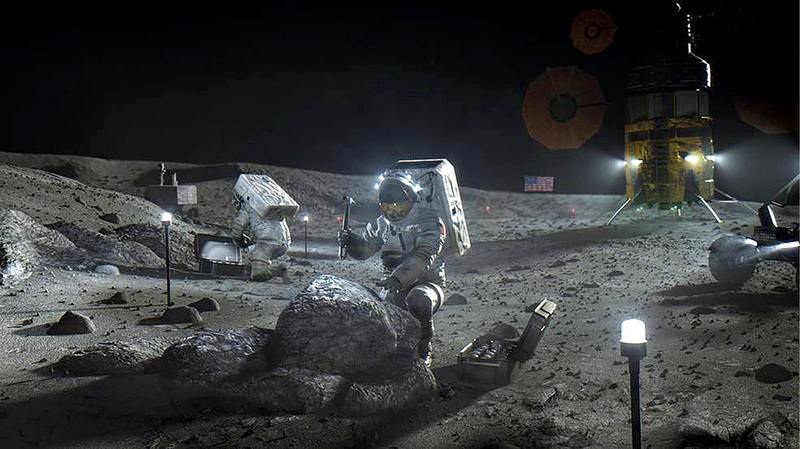 Artemis astronauts working on the Moon.
Artemis astronauts working on the Moon.
Onward and outward
Lunar samples have proved to be the cornerstone of all planetary science, revealing magnetic signatures that tell a fascinating story that we could never have learned otherwise. Samples from other worlds are ‘the gifts that keep on giving’, revealing new secrets as our technological capabilities advance.
In fact, the first indications of any water in or on the Moon came from detailed study of lunar minerals and glass beads with instrumentation that did not exist in the 1970s when the samples were first returned. The combination of instrumentation flown in orbit and on future landers will produce a new revolution in the field in just the same way that Apollo did decades ago.
The next several years will deliver many exciting findings and will be a new giant leap for all humanity as Artemis astronauts begin to establish a permanent off-world foothold for our species. With the Moon in our sights and the even bigger and more complex goal of humans living and working on Mars, new innovations and sustainable systems will need to be developed. With partners from around the world and across both the public and private sectors, it will truly be an adventure in which all can participate, and this adventure will eventually need people of all backgrounds, whether you’re a scientist or architect or accountant or farmer. Whatever your direction in life, there will surely be a point where your road and NASA’s road are the same. Join us in the Artemis Generation and share in the adventure.
About the authors
Dr James Green is a magnetospheric scientist. He is currently the NASA Chief Scientist and was previously the director of the Planetary Science Division at NASA Headquarters. He received his PhD in Space Physics from the University of Iowa in 1979 and has also worked at Goddard Space Flight Center and Marshall Space Flight Center.
Dr David Draper is a comparative planetary petrologist who specialises in the experimental study of the interiors of terrestrial planets. He is currently the NASA Deputy Chief Scientist, having previously led the Astromaterials Research Office at NASA Johnson Space Center. He received his PhD in Geological Sciences from the University of Oregon in 1991.





